OFFSHORE WIND TURBINES
Siemens Gamesa Suspends Plans for Offshore Wind Blade Plant in Virginia
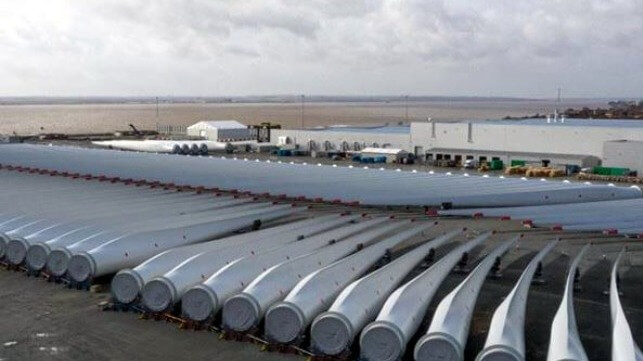
Siemens Gamesa, the European supplier that leads the global market for offshore wind turbines, has suspended plans to build a $200 million turbine blade factory at Virginia's Portsmouth Marine Terminal.
Siemens Gamesa confirmed Friday that it would not be moving ahead with its plans for the 80-acre manufacturing site, citing problems meeting "development milestones."
The cancellation is the latest in a series of setbacks for U.S. offshore wind, as well as for political ambitions to localize the industry's suppliers in the United States. When it was first announced in 2021, the Portsmouth site was the first investment by a major turbine manufacturer in the U.S. supply chain, and it was heralded as a landmark development. “Make no mistake: Virginia is building a new industry in renewable energy, with more new jobs to follow, and that’s good news for our country," said then-governor Ralph Northam at the time.
But times have changed: Like other suppliers, Siemens Gamesa faces a challenging business environment in the U.S. market. Orsted has just canceled its Ocean Wind project off New Jersey (a GE-equipped project), and a slew of others are working to renegotiate their power-purchase agreements with utility customers. Costs have soared alongside interest rates and supply chain challenges, and offshore wind developers warn that the sales contracts they signed three years ago no longer make business sense.
Siemens Gamesa's Portsmouth plant would have produced turbine blades for the massive Coastal Virginia Offshore Wind project (CVOW), a 2.6 gigawatt wind farm planned for a site about 25 nm off Virginia Beach. The blades for CVOW and other Siemens Gamesa-supplied wind projects in North America will now come from the supplier's factories in Europe, and the switch is not expected to have a material effect on the developer, Dominion Energy.
Siemens Gamesa was also in line to supply at least three other American projects, Revolution Wind, South Fork Wind and Sunrise Wind. Revolution Wind is under construction and on track for completion, according to developer Orsted. Likewise, South Fork has installed its first turbine and is moving ahead. Sunrise Wind's future is less certain: it recently applied for a subsidy increase with New York regulators, but was denied.
The upheaval in the U.S. market creates uncertainty for all suppliers in the near term, but Siemens Gamesa also faces its own internal challenges. A spate of quality issues with its legacy onshore wind turbines is expected to cost it $2.4 billion to fix, and unrelated manufacturing delays have affected its offshore wind portfolio.
The Portsmouth plant was not its largest planned investment in the U.S. market. In February 2023, Siemens Gamesa announced plans to build a $500 million nacelle plant at Port of Coeymans in Upstate New York. It has not announced any changes to this initiative. “This proposed facility in New York is a major step forward in our desire to lead the massive U.S. offshore wind market. We’re excited by the opportunity presented by the State of New York to further develop our manufacturing footprint,” said Marc Becker, Siemens Gamesa's head of offshore, in a statement in February.
Norway Gets Strong Interest in Offshore Wind with Seven Groups Applying
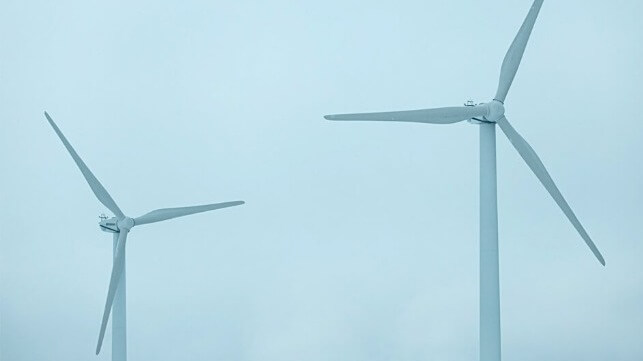
Despite the emerging global concerns on the financial aspects of the development of the offshore wind energy industry, the Norwegian government reported today that it received strong interest in the first phase of the country’s first tender. In addition to expected proposals from the major companies in Europe, including from the Norwegian energy sector, a Chinese manufacturer is also seeking to prequalify for the bidding.
The Norwegian Ministry of Petroleum and Energy received seven applications to participate in the auction for the first project area for offshore wind known as Sørlige North Sea II. Norway announced its first two target areas in 2020 as part of a goal to reach 30 GW of offshore wind energy by 2040. The country has been working to define its industry and the process and in June agreed to provide an initial $2.13 billion for the support of the first project.
“Despite large cost increases for the global offshore wind industry recently, there are several strong players applying to be able to participate in the auction round for Sørlige North Sea II,” announced Oil and Energy Minister Terje Aasland. “It is important for the government's offshore wind investment. We are now starting to assess the various applications.”
The deadline to file to pre-register was today, November 15. In the application, companies had to document that they meet the minimum criteria for sustainability and would contribute to broader positive effects. The companies also had to document the ability to complete the project.
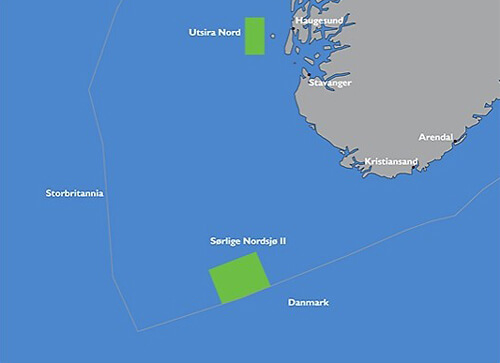
Norway is targeting two areas for its first offshore wind farm development (Norwegian Petroleum Directorate)
A total of seven applications were received, including partnerships between Equinor and RWE, Aker Offshore Wind, BP, and Statkraft, and Shell, Lyse, and Eviny. Others include the Hydroelectric Corporation, Belgium’s Parkwind in partnership with Ingka, and Norseman Wind, a company set up by Germany’s EnBW. China’s Mingyang Smart Energy, one of the large manufacturers of wind turbines, was a surprise entrant into the process.
The ministry said it will review the applications and expects to prequalify a minimum of six and a maximum of eight applicants. However, if fewer than six applicants can be prequalified, the ministry will assess whether the auction should be carried out. The tentative auction date is February 2024.
They said it was a positive step that several strong players are showing interest in the development of offshore wind on the Norwegian continental shelf. However, others including Ørsted, Vattenfall, and Eni, each of which is active elsewhere in the industry, declined to participate in the project. Earlier in the week, it was reported that Ørsted was withdrawing from a partnership in Norway as it reassesses its wind portfolio in the wake of major charges to abandon projects in the United States. Vattenfall has also reported financial challenges due to problems in the supply chain and cost increases in part due to inflation.
Sørlige Nordsjø II would be located south of Norway in the North Sea approximately 85 miles offshore. The water depth at the site is between approximately 175 feet and 230 feet with the anticipation that it will be the basis for a 1.5 GW fixed-bottom wind farm.
The Norwegian Petroleum Directorate announced earlier this week that it has collected and prepared the first data sets for offshore wind on the Norwegian shelf. They conducted underwater surveys between 2022 and 2023 for Sørlige Nordsjø II and that data is now available for download.
A survey on the second site, Utsira Nord, located to the west of Norway is currently underway and will be completed in the spring of 2024. That is expected to be a more challenging location that will require floating wind turbines.
BASF Chairman Claims Chinese Offshore Wind Turbines are "Better"
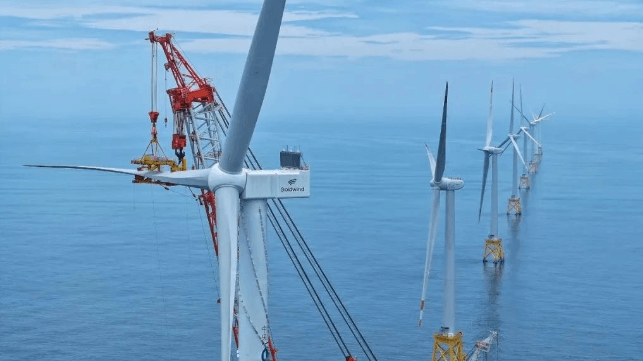
The German industrial conglomerate BASF is a giant in the world of chemicals, and operates some of the largest and longest-running chemical parks in the world. It is so big that it can build utility-scale green power projects to power itself, and it has created an in-house subspecialty in wind farm development. The 1.5 GW Hollandse Kust Zuid offshore wind farm off the Netherlands will send half its output to BASF plants in Europe, and the 0.5 GW Zhanjiang wind farm off Guangdong will send all of its power directly to a new BASF chemical park. So when BASF chairman Martin Brudermüller told reporters that he prefers Chinese offshore wind turbines, he caught a good deal of attention - and criticism.
“The Chinese are technically better than us, and they are also more cost-effective than us,” Brudermüller told Frankfurter Allgemein last week, speaking of turbine manufacturers in the EU and in China. "There is a political discussion that wind power should not be the next [EU] technology to go away. I would tend to say: It’s already gone.”
Chinese turbines are generally about 20 percent cheaper, according to industry insiders. Buyers benefit from China's lower manufacturing costs, government support, economies of scale and intense domestic price competition.
While market leading European turbine maker Siemens Gamesa is taking a $2.4 billion financial hit for quality issues this year, Chinese turbine firm Goldwind has seen its profits plummet for the opposite reason: Goldwind reports that it has put so much money into R&D and has cut its prices so deeply that it has left little for its own margins. Both companies are unprofitable, but Goldwind's customers are pocketing savings.
According to Brudermüller, developers who buy wind equipment in China might also enjoy higher quality. “Take a really close look at it on site. They have simply become good with their products," he said of Chinese turbine builders.
WindEurope, the industry body for EU equipment makers, pushed back on this notion in comments to Recharge. CEO Giles Dickson told the outlet that he was "very surprised" by the BASF chairman's remarks.
Siemens Energy CEO Christian Bruch, head of Siemens Gamesa's parent company, told analysts in an earnings call this week that Western companies like his do not generally have access to the Chinese offshore wind market. He suggested there should be controls on how much access Chinese competitors have to the EU market in order to create a level playing field.
"We can keep pace with the Chinese and even beat them on the international level if we have the right solutions available to us," he said.
Yesterday, Siemens Energy secured $12 billion in bank guarantees to support completion of its backlog of customer orders, backed by $8 billion in guarantees from the German government. S&P has downgraded the company's debt to BBB-, one step above "junk bond" status, and the government support will ensure that it has access to financing for its production plans.
UK Bows to Pressure, Hiking Auction Price of Offshore Wind
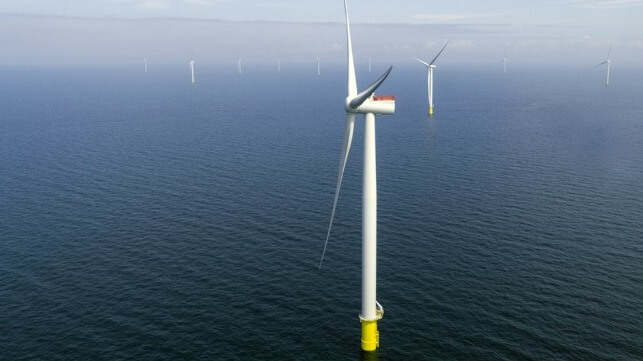
The UK government is overhauling the pricing for energy generated from offshore wind as well as other changes to its programs as it looks to reinvigorate an industry slumping under rising costs and supply chain problems. Once the overall leader in offshore wind and renewable energy, the UK faltered in September 2023 when developers failed to bid in the latest round of auctions.
The government had promised to review the process and its approach to the industry in the face of the well-publicized challenges brought on by global inflation, supply chain problems, lack of capacity, and other challenges for offshore wind development. In addition to not receiving bids in the last auction, the UK like the U.S. has seen pending projects put on hold. Swedish company Vattenfall, which is one of the leaders in offshore wind, announced in July 2023 that it had shelved plans for a UK wind farm due to come online in 2027 providing 1.4 GW as the first phase in an area that might generate a total capacity of 3.6 GW. Ørsted also recently warned that it was reviewing planned UK projects after the company backed out of large projects in the U.S. over rising costs and diminished returns.
The UK government highlights that it has awarded contracts totaling around 30 GW of renewable capacity in the decade since 2014. Five of the world’s largest operational wind farms are in the UK with the country having gone from six percent of its electric energy from renewables in 2010 to 48 percent in the first quarter of this year.
“We recognize that there have been global challenges in this sector and our new annual auction allows us to reflect this,” said UK Energy Security Secretary Claire Coutinho. “Today we have started the process of our latest Contracts for Difference auction for renewables, opening in March next year.”
Following what the government called an extensive review of the industry, for the annual auction in 2024 the government is raising the maximum price offshore wind and other renewable energy projects can receive under the Contracts for Difference (CfD) scheme, a system that guarantees the price for electricity generated. Experts cite the program as having been a key contributor to the UK’s success in developing offshore wind and renewables and while the energy price to consumers will increase, they contend it is still the most economical source of electricity.
The UK is increasing the maximum price for offshore wind projects by two-thirds (66 percent) going from approximately $55 per MWh to nearly $91 per MWh on fixed-bottom projects. For floating wind projects, the pricing will be increased by 52 percent to nearly $220 per MWh. Under the CdF scheme, the government makes up the difference if energy prices fall below the set levels, while operators have to pay back consumers if energy prices go above the levels set out by the government.
According to the UK’s Department for Energy Security and Net Zero which announced the changes today, the dramatic price increases will ensure the projects are sustainably priced and economically viable to compete in the next round of auctions. Developers in the U.S. have been seeking similar allowances asking state regulators to permit them to renegotiate their power purchase agreements with local utilities. Massachusetts and New York, for example, both refused the applications from developers triggering a scenario where the developers have walked away from their projects preferring to pay cancelation penalties and let the projects be rebid as opposed to proceeding under the negotiated terms.
The UK government reports it is also dedicating a separate funding pot to offshore wind and renewables in anticipation of a high number of projects as a result of these changes. The ministers are contending that the move provides further clarity and confidence in the offshore wind sector. Dan McGrail, CEO of RenewableUK predicted that there would be record investment next year with at least 10 projects likely to be eligible able to power 8.5 million homes and reduce the UK’s need for gas by 39 percent.
“We very much welcome the government responding to the increased global competition and the economic challenges facing developers by showing more ambition and giving greater confidence to investors, which will help build a domestic green powerhouse that benefits our own economy and people,” said Emma Pinchbeck, Energy UK’s Chief Executive.
The government also in the announcement issued today, November 16, proposed additional changes to the system to further enhance development. They have already switched to an annual auction process to encourage developers. Starting with the 2025 auctions, it plans to add in additional criteria including the project’s ability to reduce carbon emissions in its supply chains. The government plans to look for additional elements beyond just a low price in choosing future projects.
No comments:
Post a Comment